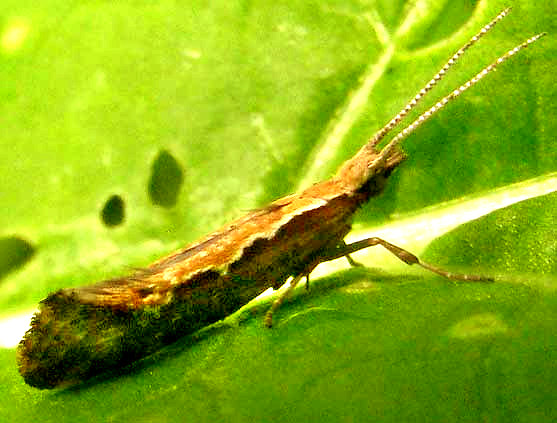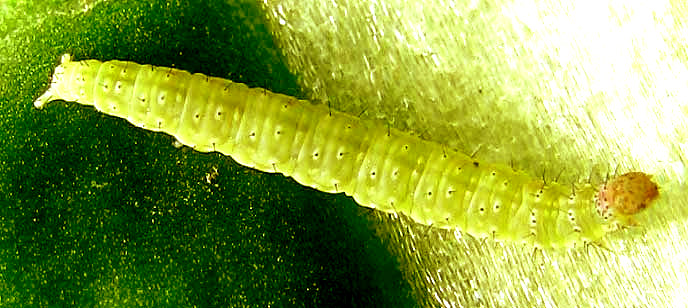Excerpts from Jim Conrad's
Naturalist Newsletter

from the November 24, 2013 Newsletter issued from the Frio Canyon Nature Education Center in the valley of the Dry Frio River in northern Uvalde County, southwestern Texas, on the southern border of the Edwards Plateau; elevation ~1750m (~5750 ft); N29.62°, W99.86°; USA
DIAMONDBACK MOTH
Sometimes when I step into the little greenhouse with its burgeoning raised beds of mustard and turnip greens, bok choy, collards, chard and more, a flurry of tiny white moths rises from the beds, settling on the greenhouse's white-plastic sides or back into the herbage. With a body length of only about ¼ inch (6mm), when these very small moths land you can see that they are very slender and possess long, stiff, minutely banded, forward-projecting antennae, as shown above.
This is the Diamondback Moth, PLUTELLA XYLOSTELLA, one of the most important pests of Mustard-Family, or "cruciferous," crops in the world. My mustard and turnip greens, bok choy, and collards are all cruciferous. Probably native of Europe, Diamondback Moths were first observed in North America in 1854, in Illinois, spread to Florida and the Rocky Mountains by 1883, and were reported from British Columbia by 1905. Today they're found worldwide. In the picture you can see that the back edges of the moth's wings bear fringes of slender, hairlike items, and that at the moth's rear the fringes turn upward, like an airplane's vertical tail fin.
The moth's larval stage, a green caterpillar, does the damage in gardens. Though small, they can occur in such numbers that they leave nothing in a bed of greens but skeletonized leaves -- something that happened to our crop last year, and may happen again. That's one below:

Damage by Diamondback Moth caterpillars is hard to control. During the 1980s they developed resistance to pyrethroids and soon afterwards virtually all insecticides became ineffective on them. Normally the organic gardener thinks of Dipel, containing the bacterium Bacillus thuringiensis, which gives caterpillars a fatal illness. However, Diamondback Moth caterpillars have become the first insect found to become resistant to biological control by Bacillus thuringiensis in the field. In the North the species dies back each winter from the cold, but down here our winters aren't cold enough to wipe them out.
So, each morning when I enter the greenhouse and the little flurry of moths rises to greet me, the thought I always have is that this is the beginning of something that before long will affect mankind profoundly: The pest and disease organisms that for decades have been held in check by chemicals, antibiotics and the like, now are acquiring resistance.
I can only imagine what changes will be wrought when resistance is acquired not only by Diamondback Moths but also the organisms that plague all our major crops, and the microbes that affect us humans, as well.